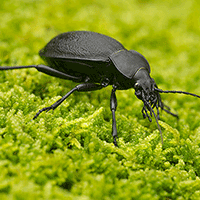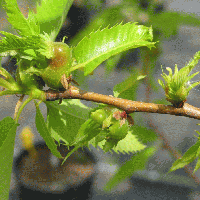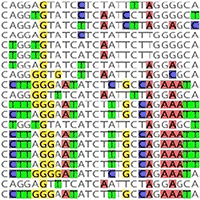
Discovering interaction between oaks and carabid beetles on a local scale by point pattern analysis
Sven Wagner (1) , Alexandra Wehnert (1), Ka Yiu Wong (2), Dietrich Stoyan (3)
iForest - Biogeosciences and Forestry, Volume 9, Issue 4, Pages 618-625 (2016)
doi: https://doi.org/10.3832/ifor1952-009
Published: May 06, 2016 - Copyright © 2016 SISEF
Research Articles
Abstract
The understanding of habitat demands of single species needs an explicit habitat element approach which includes both the effect of intensity of the habitat element on the species population and the spatial effect of that habitat element in a given matrix (e.g., forest or water). An established tool in ecological research for this purpose is the point pattern analysis, which yields information on relationships between organisms and habitat elements, as well as on interactions among individuals. However, the application of this tool seems to be restricted so far to locally fixed species and habitat elements. As our model system consists of carabid beetles and single old oak trees in a Scots pine forest, we needed to address the issue of fauna mobility in point pattern analysis. We adopted a random field approach to transform the lattice beetle traps data to point data. For the resulting bivariate point pattern we applied the toroidal shift test to verify the independence of tree and beetle distribution. To overcome the problem of irregular window shape, we reconstructed the oak data to obtain a point pattern in a larger rectangular window to make toroidal shifts possible. We could justify a positive spatial association between oak tree and carabid beetle distributions. By our results, specific spatial fields of oak influence on the beetle species can be derived which may allow for beetles supporting management measures like an increase of oak tree proportion and a more regular spatial distribution of single admixed oak trees. Those measures may increase the ecological effect of C. coriaceus as an antagonist for pest insects in mono-cultured Scots pine forests.
Keywords
Point Pattern Analysis, Species Association, Toroidal Shift Test
Authors’ Info
Authors’ address
Alexandra Wehnert
Institute of Silviculture and Forest Protection, TU Dresden, Postfach 1117, D-01735 Tharandt (Germany)
Department of Mathematics, Hong Kong Baptist University, Kowloon Tong (Hong Kong)
Institute of Stochastics, TU Bergakademie Freiberg, D-09596 Freiberg (Germany)
Corresponding author
Paper Info
Citation
Wagner S, Wehnert A, Wong KY, Stoyan D (2016). Discovering interaction between oaks and carabid beetles on a local scale by point pattern analysis. iForest 9: 618-625. - doi: 10.3832/ifor1952-009
Academic Editor
Massimo Faccoli
Paper history
Received: Dec 16, 2015
Accepted: Mar 07, 2016
First online: May 06, 2016
Publication Date: Aug 09, 2016
Publication Time: 2.00 months
Copyright Information
© SISEF - The Italian Society of Silviculture and Forest Ecology 2016
Open Access
This article is distributed under the terms of the Creative Commons Attribution-Non Commercial 4.0 International (https://creativecommons.org/licenses/by-nc/4.0/), which permits unrestricted use, distribution, and reproduction in any medium, provided you give appropriate credit to the original author(s) and the source, provide a link to the Creative Commons license, and indicate if changes were made.
Web Metrics
Breakdown by View Type
Article Usage
Total Article Views: 49455
(from publication date up to now)
Breakdown by View Type
HTML Page Views: 41290
Abstract Page Views: 2987
PDF Downloads: 3759
Citation/Reference Downloads: 63
XML Downloads: 1356
Web Metrics
Days since publication: 3531
Overall contacts: 49455
Avg. contacts per week: 98.04
Citation Metrics
Article Citations
Article citations are based on data periodically collected from the Clarivate Web of Science web site
(last update: Mar 2025)
Total number of cites (since 2016): 5
Average cites per year: 0.50
Publication Metrics
by Dimensions ©
Articles citing this article
List of the papers citing this article based on CrossRef Cited-by.
References
Traps for cave inhabiting insects. Journal of the Elisha Mitchell Scientific Society 46: 259-266.
Gscholar
On the role of natural enemies in preventing competitive exclusion in some marine animals and in rain forests. In: “Dynamics of Populations” (den Boer PJ, Gradwell GR eds). Centre for Agricultural Publishing and Documentation, Wageningen, Netherland, pp. 298-312.
Gscholar
Effects of forest management on ground-dwelling beetles (Coleoptera; Carabidae, Staphylinidae) in Central Europe are mainly mediated by changes in forest structure. Forest Ecology and Management 329: 166-176.
CrossRef | Gscholar
Methods for analyzing several types of points. Journal of the Royal Statistical Society - Series B 44: 406-413.
Gscholar
Biology and ecology of immature stages of ground beetles (Carabidae). In: Proceedings of the “11th European Carabidologists’ Meeting” (Lövei GL, Toft S eds). Århus (Denmark) 21-24 July 2003. DIAS Report no. 114, Ministry of Food, Agriculture and Fisheries, Danish Institute of Agricultural, Denmark, pp. 183-208.
Gscholar
Wildlife habitat management: concepts and applications. Taylor and Francis, CRC Press, Boca Raton, FL, USA, pp. 319.
Gscholar
The significance of the pitfall trapping method for solving ecological problems. Zoologische Jahrbücher Systematik 111: 281-305. [in German]
Gscholar
Aims and methods of vegetation ecology. Blackburn Press, New York, London, pp. 77.
Gscholar
Untersuchungen zum Raum-Zeit-Muster epigäischer Carabidae an der Wald-Offenland-Grenze [Investigations on space-time patterns in epigeous Carabids at the edge of forest to open field]. Forstwissenschaftliche Beiträge Tharandt / Contributions to Forest Sciences 21, Eugen Ulmer, Stuttgart, Germany, pp. 372.
Gscholar
Wirkungen einzelbaumweise eingemischter Trauben-Eichen (Quercus petraea (Matt.) Liebl.) auf den Oberbodenzustand in Kiefernbeständen (Pinus sylvestris L.) [Single tree effects of sessile oak (Quercus petraea (Matt.) Liebl.) within pure pine stands (Pinus sylvestris L.) on topsoil properties]. Allgemeine Forst- u. Jagd-Zeitung 178: 172-179. [in German]
Gscholar
Räumliche Effekte von Totholzstrukturen bei Landschnecken (Mollusca, Gastropoda) [Spatial effects of coarse woody debris on terrestrial gastropods]. Forst und Holz 64: 22-27.
Gscholar
Carabid beetles in their environments: a study on habitat selection by adaptations in physiology and behaviour. Zoophysiology and Ecology Volume 10. Springer, Berlin-Heidelberg-New York, pp. 369.
Gscholar
The genus Carabus in Europe. A synthesis. Fauna Europaea Evertebrata No. 2, Pensoft Pub., Sofia-Moscow-Leiden, pp. 512.
Gscholar
Laufkäfer Beobachtungen-Lebensweise [Observations on epigeous Carabids behaviour]. Naturbuch-Verlag, Augsburg, Germany, pp. 295. [in German]
Gscholar
Ecological methods in forest pest management. Oxford University Press, Oxford, New York, USA, pp. 228.
Gscholar
Wirkungen einzelbaumweise eingemischter Trauben-Eichen (Quercus petraea [Matt.] Liebl.) in Wäldern der Gemeinen Kiefer (Pinus sylvestris L.) auf die Arthropodenfauna unter besonderer Berücksichtigung der Laufkäfer (Carabidae) [Effects of single-tree admixed Sessile Oaks (Quercus petraea (Matt.) Liebl.) in pure stands of Scots Pine (Pinus sylvestris L.) on epigeous arthropods - with special consideration of ground beetles (Carabidae)]. Allgemeine Forst-u. Jagd-Zeitung 181: 133-143. [in German]
Gscholar
Handbook of spatial point-pattern analysis in ecology. Applied Environmental Statistics. CRC Press, Taylor and Francis Group, Boca Raton, FL, USA, pp. 510.
Gscholar

















